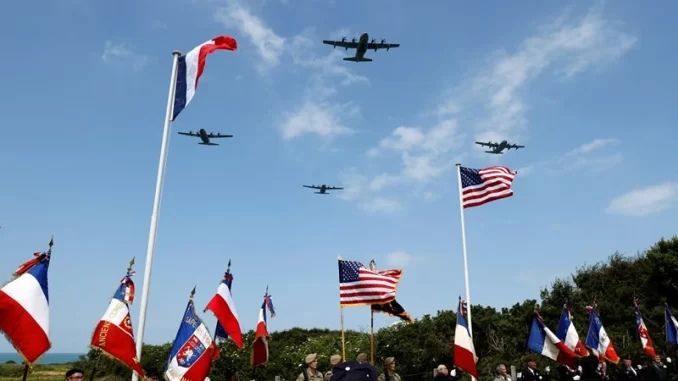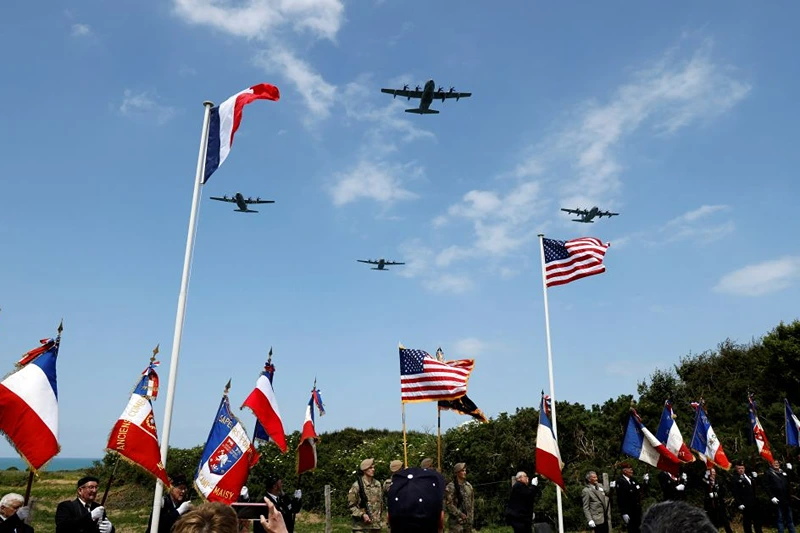

OAN’s James Meyers
11:12 AM – Wednesday, June 5, 2024
As tears come down their faces and memories are shared, this year will be the largest D-Day commemoration in history as the last surviving American World War II veterans head back to the beaches of Normandy to remember those who lost their lives giving the ultimate sacrifice.
Advertisement
80 years later veterans of World War II, who are likely returning to France for one last time, showed up on Tuesday to what was the bloodiest of five Allied landing beaches on June 6, 1944. They remembered fallen friends, the terror they faced in combat and were grateful for being able to survive the war. They also mourned those who were killed that did not make it back home.
They also bore a message for generations behind them, who owe them so much: Don’t forget what we did.
“They probably wouldn’t be here if we hadn’t been successful,” said Llilburn “Bill” Wall, who flew bombers in WWII and will celebrate his 101st birthday this week as world leaders gather in France to pay homage to the D-Day generation.
As time has moved on, D-Day anniversaries in Normandy have been more fun-fair filled, with WWII-era fans dressed in uniforms and driving around restored vehicles of that era.
However, as less and less WWII veterans have been able to show up each year, it raises the question about whether the memories, tragedies and lessons of the historic war will fade when they are gone.
“There are things worth fighting for. Although I wish there was another way to do it than to try to kill each other. But sometimes you’re called upon to do something and you just do it. You know? That’s it. These people looked death in the face and just kept right on coming,” said Walter Stitt, who turns 100 in July and fought in tanks — surviving the destruction of three.
“All those young men that never had a chance to go home and find a love of their life and hold their children in their arms,” he said on Omaha, wiping away a tear.
On the bluffs above Omaha, at the Normandy American Cemetery with 9,387 immaculately tended graves, 100-year-old Bob Gibson paid tribute to comrades who fell on D-Day, when he landed on the other, less-bloody American landing beach, code-named Utah.
“You don’t want other people to go through the same thing,” he said. “Because I’ve seen a lot of these boys that never even made the beach, believe me. And we were all 18, 19 years old.”
“I’m glad I made it. The old boy upstairs took care of me,” he said, gesturing skyward.
On that fateful day across the Normandy coast where the largest-ever land, sea and air assault penetrated Adolf Hitler’s defenses in western Europe on D-Day and helped lead to his downfall 11 months later, Allied veterans are the VIPs of this week’s 80th anniversary celebrations.
Additionally, more veterans were on their way on Tuesday, traveling by ferry from southern England, which 23,000 Allied airborne troops flew over to drop on D-Day in Normandy. It also led to more than 132,000 others crossed aboard thousands of ships that stretched for miles, landing on Utah and Omaha and three other code-named beaches: Gold, Juno and Sword.
“It looked like you could walk across the Channel using boats as stepping stones,” recalled 100-year-old Robert Pedigo, who was a nose gunner aboard a B-24 bomber that flew over the landing beaches on D-Day to hit German forces from the air.
Back at base on D-Day night, he was told the Allies had suffered thousands of casualties.
“Overwhelming,” he recalled. Although his bombing mission that day proved to be among the “easiest” of 30 he flew over occupied France and Nazi Germany, “the emotional impact was the greatest.”
More than 4,400 Allied troops were killed on D-Day, including over 2,500 Americans. The Allied toll grew rapidly in the Battle of Normandy that ensued, with 73,000 killed and 153,000 wounded.
After eight decades, veterans are making new memories along with the older tragic ones that are already in their minds.
A pipe band struck up a stirring rendition of “Brave Scotland.” Sailors stood at attention, fireboats blasted their hoses in an arc and a military transport plane flew past twice.
Royal Air Force (RAF) veteran Bernard Morgan, who worked in communications on D-Day, chuckled: “It was more pleasant coming today than it was 80 years ago.”
Stay informed! Receive breaking news blasts directly to your inbox for free. Subscribe here. https://www.oann.com/alerts

